美国商标法-合理使用相关法条-15USC1125
论商标合理使用

案 ,介绍 美国商标合理 使用的法定合理 使用原 则,并探 讨 商标 合理使用原 则的最新 发展 ,为我 国的商 标合理使用 制度 提供借 鉴。
二 、法定合理使用
商标 法的 目的在于使 “ 商标所 有人可 以从与商标相 关的 商誉 中受益 ,消 费者也能 区分不同的生产者 。 ” 所 以商标 必须 具有显著性 和识别性 。一 般而言 ,本商 品的通用名 称和 图形 ,或直接表 示商 品的质量 、主要原料 、功能、用途 等等 的描 述性名词 ,因为欠缺显 著性而得不到注 册 。但是如 果此 类名 词因为长期 使用 、公众认 可等原 因具有 新的意义 ,足 以 表 明商品来源的 ,那就具备了第二含义,从而 能够 得到 注册, 取得 商标权 。 商标权 的独 占性和排他 性将 阻碍其 他人对某 些原 本在公共 领域 可获得 的词汇短语 的使用 ,所 以当其 他人 是在 基本含 义、叙述性含 义上使用该词 ,就应允许其合 理使 用 。出于促进市 场竞争 、保护 消费者利益 、防止商标权 滥用 以及促进 言论 自由之需要 ,商标合理使用制度应运而 生。 美 国商标法上的法定合理使用必须具备三个 条件 :一 是 描述 自己的商品或服务;二是善意 的、合理 的使用 ;三是 叙 述性使用而 非商标性使用 。下文将分析近几年美 国上诉法 院 的生效判例 ,探 讨法定合理使用的善意标准和叙述性使用标
2 1 年 0 1
法商论坛
第二卷
论商标合理使用
单 明瑛
( 东政 法大学 ,上海 ,2 04 ) 华 002
摘 要 :商标合理使用 是指非 商标 权人 未经过商标权人允许 ,善 意合理地使用注 册商标而不构成侵权的行为。美 国在 商标 合理 使用原则的立法和司法实践方面都 比较发达 , 本文通过简要分析 H n l y f .v P o r d ,I c 案和 I tr a in l tm ese M g . rPie n . n e n t o a a p S A t n .V . .P sa e v c 案 ,分析美 国商标 合理使用的法定合理使用原则的构成要件 ,并探讨指示性合理使用原则 r ,I c .U S o t lS r i e 在美 国的发展。 同时介绍我 国商标合理使用 的相 关规 定及 司法实践,并就我国的商标合理使用 制度提 出建议 。 关键 词 :商标合理使用 ;法定合理使用 ;指示性合 理使用
美国知识产权法制简况

美国知识产权法制简况1. 法律体系和组织结构美国的知识产权法制主要包括专利法、商标法、版权法和商业秘密保护法。
这些法律分别由联邦政府和州政府来管理和执行。
联邦政府负责颁发专利和注册商标,版权则是由联邦政府的版权局管理。
州政府也可以制定并执行一些与知识产权相关的法律。
2. 专利法美国专利法主要通过授予专利权来保护发明的创造性和实用性。
根据美国专利法,发明者可以申请专利来保护他们的发明,专利权持有者有权阻止他人在一定时期内制造、使用、销售或引入该发明。
专利一般有效期为20年。
3. 商标法美国商标法主要通过注册商标来保护商业标识,如商标、服务标记和商品名称等。
商标注册可以为商标权持有者提供排他性使用的权利,并赋予其阻止他人非法使用或冒用商标的权力。
美国商标法也保护产生混淆的商标使用行为。
4. 版权法美国版权法主要保护创作性的作品,例如文学、音乐、戏剧、图案和电影等。
根据美国版权法,作品的创作者在作品创作完成时即拥有版权。
版权的持续时间在作者寿命加上其他期限,为作者一生加70年。
5. 商业秘密保护法美国商业秘密保护法主要保护商业信息的机密性。
商业秘密可以是任何有商业价值且未公开的信息,例如客户列表、制造过程和技术配方等。
美国商业秘密保护法要求保持商业秘密的机密性,并禁止他人通过不正当手段获取商业秘密。
,美国的知识产权法制为创新和创作提供了强有力的保护。
这些法律的执行机构会积极维护知识产权的权益,以促进创新和经济发展。
美国也是世界知识产权组织的成员国,并与其他国家保持合作,以加强知识产权保护和推动国际知识产权事务的发展。
美国商标法
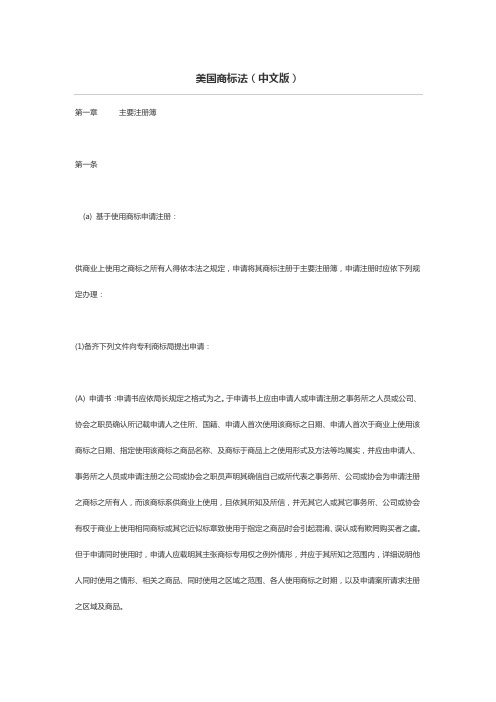
第一章主要注册簿第一条(a) 基于使用商标申请注册:供商业上使用之商标之所有人得依本法之规定,申请将其商标注册于主要注册簿,申请注册时应依下列规定办理:(1)备齐下列文件向专利商标局提出申请:(A) 申请书:申请书应依局长规定之格式为之。
于申请书上应由申请人或申请注册之事务所之人员或公司、协会之职员确认所记载申请人之住所、国籍、申请人首次使用该商标之日期、申请人首次于商业上使用该商标之日期、指定使用该商标之商品名称、及商标于商品上之使用形式及方法等均属实,并应由申请人、事务所之人员或申请注册之公司或协会之职员声明其确信自己或所代表之事务所、公司或协会为申请注册之商标之所有人,而该商标系供商业上使用,且依其所知及所信,并无其它人或其它事务所、公司或协会有权于商业上使用相同商标或其它近似标章致使用于指定之商品时会引起混淆、误认或有欺罔购买者之虞。
但于申请同时使用时,申请人应载明其主张商标专用权之例外情形,并应于其所知之范围内,详细说明他人同时使用之情形、相关之商品、同时使用之区域之范围、各人使用商标之时期,以及申请案所请求注册之区域及商品。
(B) 商标图样。
(C) 使用商标之样张或复制品。
所需检附样张或复制品之数量依局长之要求定之。
(2) 向专利商标局缴交注册费用。
(3) 遵照局长在不与法律抵触之范围内所发布之规则、办法。
(b)基于使用商标之意图申请注册凡善意欲于商业上使用商标者,且有情况足以显示其为善意时,得依本法申请注册于主要注册簿,申请时应依下列规定办理:(1) 备齐下列文件向专利商标局提出申请:(A) 申请书:申请书应依局长规定之格式为之。
申请书上应由申请人或申请注册之事务所之人员或公司、协会之职员确认所记载申请人之住所、国籍、申请人善意于商业上使用商标之意图,申请人将善意使用商标之商品,将来使用于商品上之商标形式及方法等均属实,并应由申请人,或申请注册之事务所之人员、或公司、协会之职员声明其确信自己或所代表之事务所、公司或协会有权于商业上使用该商标,且依其所知及所信,并无其它人或其它事务所、公司或协会有权于商业上使用相同商标或其它近似之标志,致使用于指定之商品时,会引起混淆、误认或有欺瞒购买者之虞。
美国商标法.docx

第一章主要注册簿第一条(a) 基于使用商标申请注册:供商业上使用之商标之所有人得依本法之规定,申请将其商标注册于主要注册簿,申请注册时应依下列规定办理:(1)备齐下列文件向专利商标局提出申请:(A) 申请书:申请书应依局长规定之格式为之。
于申请书上应由申请人或申请注册之事务所之人员或公司、协会之职员确认所记载申请人之住所、国籍、申请人首次使用该商标之日期、申请人首次于商业上使用该商标之日期、指定使用该商标之商品名称、及商标于商品上之使用形式及方法等均属实,并应由申请人、事务所之人员或申请注册之公司或协会之职员声明其确信自己或所代表之事务所、公司或协会为申请注册之商标之所有人,而该商标系供商业上使用,且依其所知及所信,并无其它人或其它事务所、公司或协会有权于商业上使用相同商标或其它近似标章致使用于指定之商品时会引起混淆、误认或有欺罔购买者之虞。
但于申请同时使用时,申请人应载明其主张商标专用权之例外情形,并应于其所知之范围内,详细说明他人同时使用之情形、相关之商品、同时使用之区域之范围、各人使用商标之时期,以及申请案所请求注册之区域及商品。
(B) 商标图样。
(C) 使用商标之样张或复制品。
所需检附样张或复制品之数量依局长之要求定之。
(2) 向专利商标局缴交注册费用。
(3) 遵照局长在不与法律抵触之范围内所发布之规则、办法。
(b)基于使用商标之意图申请注册凡善意欲于商业上使用商标者,且有情况足以显示其为善意时,得依本法申请注册于主要注册簿,申请时应依下列规定办理:(1) 备齐下列文件向专利商标局提出申请:(A) 申请书:申请书应依局长规定之格式为之。
申请书上应由申请人或申请注册之事务所之人员或公司、协会之职员确认所记载申请人之住所、国籍、申请人善意于商业上使用商标之意图,申请人将善意使用商标之商品,将来使用于商品上之商标形式及方法等均属实,并应由申请人,或申请注册之事务所之人员、或公司、协会之职员声明其确信自己或所代表之事务所、公司或协会有权于商业上使用该商标,且依其所知及所信,并无其它人或其它事务所、公司或协会有权于商业上使用相同商标或其它近似之标志,致使用于指定之商品时,会引起混淆、误认或有欺瞒购买者之虞。
商标合理使用的判断标准
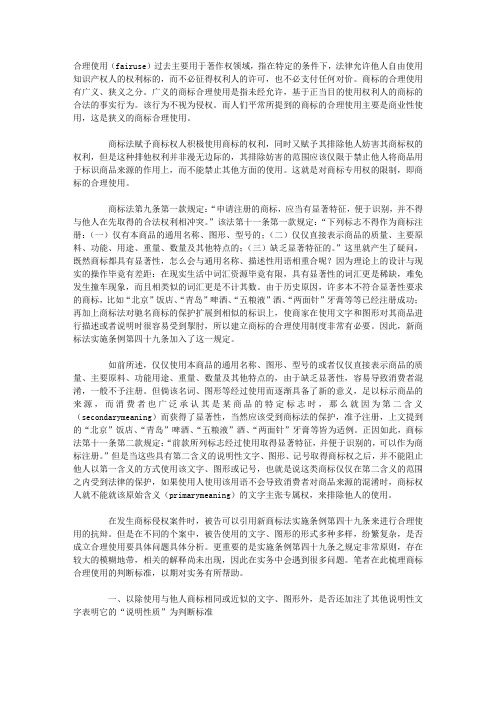
合理使用(fairuse)过去主要用于著作权领域,指在特定的条件下,法律允许他人自由使用知识产权人的权利标的,而不必征得权利人的许可,也不必支付任何对价。
商标的合理使用有广义、狭义之分。
广义的商标合理使用是指未经允许,基于正当目的使用权利人的商标的合法的事实行为。
该行为不视为侵权。
而人们平常所提到的商标的合理使用主要是商业性使用,这是狭义的商标合理使用。
商标法赋予商标权人积极使用商标的权利,同时又赋予其排除他人妨害其商标权的权利,但是这种排他权利并非漫无边际的,其排除妨害的范围应该仅限于禁止他人将商品用于标识商品来源的作用上,而不能禁止其他方面的使用。
这就是对商标专用权的限制,即商标的合理使用。
商标法第九条第一款规定:“申请注册的商标,应当有显著特征,便于识别,并不得与他人在先取得的合法权利相冲突。
”该法第十一条第一款规定:“下列标志不得作为商标注册:(一)仅有本商品的通用名称、图形、型号的;(二)仅仅直接表示商品的质量、主要原料、功能、用途、重量、数量及其他特点的;(三)缺乏显著特征的。
”这里就产生了疑问,既然商标都具有显著性,怎么会与通用名称、描述性用语相重合呢?因为理论上的设计与现实的操作毕竟有差距:在现实生活中词汇资源毕竟有限,具有显著性的词汇更是稀缺,难免发生撞车现象,而且相类似的词汇更是不计其数。
由于历史原因,许多本不符合显著性要求的商标,比如“北京”饭店、“青岛”啤酒、“五粮液”酒、“两面针”牙膏等等已经注册成功;再加上商标法对驰名商标的保护扩展到相似的标识上,使商家在使用文字和图形对其商品进行描述或者说明时很容易受到掣肘,所以建立商标的合理使用制度非常有必要。
因此,新商标法实施条例第四十九条加入了这一规定。
如前所述,仅仅使用本商品的通用名称、图形、型号的或者仅仅直接表示商品的质量、主要原料、功能用途、重量、数量及其他特点的,由于缺乏显著性,容易导致消费者混淆,一般不予注册。
但倘该名词、图形等经过使用而逐渐具备了新的意义,足以标示商品的来源,而消费者也广泛承认其是某商品的特定标志时,那么就因为第二含义(secondarymeaning)而获得了显著性,当然应该受到商标法的保护,准予注册,上文提到的“北京”饭店、“青岛”啤酒、“五粮液”酒、“两面针”牙膏等皆为适例。
商标的合理使用

指示性合理使用
指示性合理使用,又称为商标被提及的合理使 用、指明商标权人的商标合理使用,是指非商 标权人为了说明自己的商品或服务的真实情况, 不得不提及商标权人的商标来描述其商品或服 务,不构成商标侵权的行为。
杜颖:《指明商标权人的商标合理使用制度——以美 国法为中心的比较分析》,载《法学论坛》2008 。
德国《商标法》第23条规定:“只要不与善良风 俗相冲突,商标或商业标识所有人应无权禁止 第三人在商业活动中使用:(a)其姓名或地址;(b) 与该商标或商业标识相同或近似的,但与商品 或服务特征或属性,尤其是与其种类、质量、 用途、价值、地理来源或商品的生产日期或服 务提供的有关标志……”。 李萍:《当代外国商标法》,人民法院出版社, 2003年第一版
北京市高级人民法院《关于审理商标民事纠纷案件若干问题的解 答》(京高法发(2006)68号)。
根据该《解答》,以下六种情形所涉及的商标使用行为属 于的合理使用: (l)使用注册商标中含有本商品的通用名称、图形、型号的; (2)使用注册商标中直接表示商品的性质、用途、质量、主 要原料、种类及 其他特征的标志的; (3)在销售商品时,为说明来源、指示用途等在必要范围内 使用他人注册商标标志的; (4)规范使用与他人注册商标相同或者近似的自己的企业名 称及其字号的; (5)使用与他人注册商标相同或者近似的自己所在地的地名 的; (6)其他属于正当使用商标标志的行为。
商标合理使用
商标合理使用的概念
商标合理使用是指在一定条件下,允许非商标 权人善意使用他人注册商标或者与他人注册商 标相同或相似的标志而不构成侵权的行为。商 标合理使用的对象包括: 一是与注册商标相同或相似的标志; 二是注册商标本身。
商标的合理使用制度

商标合理使用制 度的意义
商标合理使用制 度的适用范围
商标合理使用制 度的实践案例
• 《商标法》第57条:有下列行为之一的,均属侵犯注册商标专用权: (一)未经商标注册人的许可,在同一种商品上使用与其注册商标相同的商标的; (二)未经商标注册人的许可, 在同一种商品上使用与其注册商标近似的商标,或者在类似商品上使用与其注册商标相同或者近似的商标,容易导致混淆的; (三)销售侵犯注册商标专用权的商品的; (四)伪造、 擅自制造他人注册商标标识或者销售伪造、擅自制造的注册商标标识的; (五)未经商标注册人同意,更换其注册商标并将该更换商标的商品又投入市场的; (六)故意为侵犯他人商 标专用权行为提供便利条件,帮助他人实施侵犯商标专用权行为的; (七)给他人的注册商标专用权造成其他损害的。
商标侵权行为的类型:直接侵权、间接侵权、反向假冒、淡化侵权等。
商标侵权行为的定义和类型 商标合理使用的定义和范围
商标合理使用与侵权行为的 区分标准
商标合理使用与侵权行为的 法律后果
案例一:某公司使用他人商标进行广告宣传,被认定为商标侵权 案例二:某公司使用他人商标进行产品促销,被认定为不正当竞争 案例三:某公司使用他人商标进行产品研发,被认定为侵权行为 案例四:某公司使用他人商标进行公益活动,被认定为合法行为
,
汇报人:
目录
CONTENTS
商标在先使用权的法条

一、商标在先使用权的法条1、在他人注册商标的申请日之前,就已经有使用的事实这是对使用人的使用时间的要求,如果不具备这一条件,就没有“在先使用”,也无法产生在先使用权,并以此作为侵害商标权的抗辩事由。
需要注意的是,使用不仅限于现有使用人的使用,如果曾经发生过业务承继关系的,现有使用人作为承继人的使用当然可以作为本条件中的使用。
被承继人先前的使用应当视为现有使用人的使用。
换言之,在先使用商标的使用时间以该商标首次商业使用的时间为准。
2、在先使用的商标与注册商标相同或者近似,且使用商品或服务相同或者类似在通常情形下,如果在先使用的商标与注册商标在商标图样上不构成相同或者近似,或者使用商品不属于相同或者类似商品,则使用人当然有权继续使用甚至申请注册该商标。
如果在先使用的商标与注册商标构成使用在相同或类似商品上的近似商标,依照我国《商标法》有关申请在先和注册原则的一般规定,则未注册商标不得继续使用,否则会构成对注册商标权的侵害。
但法律应当维护诚信,而不应当禁止或者制裁正当使用行为,因此有必要在上述原则下创设例外之规定即商标在先使用权。
3、在先使用人必须在其商品上连续使用该商标所谓连续使用,就是指在先使用人在其商品上连续不中断地使用该商标。
如果在先使用人在他人注册商标的申请日之前曾有使用事实,但无正当理由而中断使用的,不得继续使用该商标。
理由在于:第一,商标在先使用权作为注册原则的例外,是为了保护在先使用人的利益,如果在先使用人的使用已经中断,其就该商标不再享有任何利益,自无保护的必要。
第二,如果只是曾有使用事实,在先使用人在他人商标注册后仍可以重新使用,将会从根本上动摇商标注册制度,不利于保护商标注册人的利益。
第三,在使用中断后允许重新使用,不利于维护正常的公平竞争关系和维护消费者的利益。
所谓正当理由,是指非因使用人主观上的原因中断使用。
若有正当理由中断使用的,不视为缺乏连续使用这一条件。
如在先使用商标所使用的商品为季节性造成商标中止使用。
美国商标的使用证据要求、审查趋势、潜在风险及应对策略
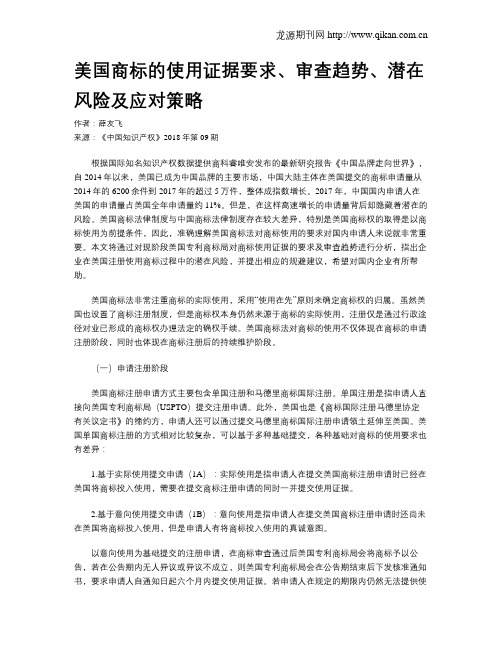
美国商标的使用证据要求、审查趋势、潜在风险及应对策略作者:薛友飞来源:《中国知识产权》2018年第09期根据国际知名知识产权数据提供商科睿唯安发布的最新研究报告《中国品牌走向世界》,自2014年以来,美国已成为中国品牌的主要市场,中国大陆主体在美国提交的商标申请量从2014年的6200余件到2017年的超过5万件,整体成指数增长。
2017年,中国国内申请人在美国的申请量占美国全年申请量约11%。
但是,在这样高速增长的申请量背后却隐藏着潜在的风险。
美国商标法律制度与中国商标法律制度存在较大差异,特别是美国商标权的取得是以商标使用为前提条件,因此,准确理解美国商标法对商标使用的要求对国内申请人来说就非常重要。
本文将通过对现阶段美国专利商标局对商标使用证据的要求及审查趋势进行分析,指出企业在美国注册使用商标过程中的潜在风险,并提出相应的规避建议,希望对国内企业有所帮助。
美国商标法非常注重商标的实际使用,采用“使用在先”原则来确定商标权的归属。
虽然美国也设置了商标注册制度,但是商标权本身仍然来源于商标的实际使用,注册仅是通过行政途径对业已形成的商标权办理法定的确权手续。
美国商标法对商标的使用不仅体现在商标的申请注册阶段,同时也体现在商标注册后的持续维护阶段。
(一)申请注册阶段美国商标注册申请方式主要包含单国注册和马德里商标国际注册。
单国注册是指申请人直接向美国专利商标局(USPTO)提交注册申请。
此外,美国也是《商标国际注册马德里协定有关议定书》的缔约方,申请人还可以通过提交马德里商标国际注册申请领土延伸至美国。
美国单国商标注册的方式相对比较复杂,可以基于多种基础提交,各种基础对商标的使用要求也有差异:1.基于实际使用提交申请(1A):实际使用是指申请人在提交美国商标注册申请时已经在美国将商标投入使用,需要在提交商标注册申请的同时一并提交使用证据。
2.基于意向使用提交申请(1B):意向使用是指申请人在提交美国商标注册申请时还尚未在美国将商标投入使用,但是申请人有将商标投入使用的真诚意图。
美国商标侵权标准

美国商标侵权标准一、在美国,判断商标侵权的最基本的标准一个商标的拥有权,是由商标的注册时间先后决定的。
也就是说,谁先使用一个商标,谁就拥有该商标。
因此,判断一个商标是否侵犯另一个商标的权利,就看谁先使用这个商标。
但是,并不是任何两个相同的商标都不允许同时存在。
这时,判断商标是否侵权的另一个标准是,新商标的出现是否会让第一个商标的客户错误地把第二个相同的商标当成第一个商标。
如果两个商标是在完全不同的行业或不同的地区,有着不同的顾客群,并且有着不同的销售渠道,那两个相同的商标是可以同时存在的。
但是,这一判断标准对哪些著名的商标并不适用。
比如说,如果您使用麦当劳的商标甚至是相似的图案去卖汽车,这看起来似乎与麦当劳卖的快餐风马牛毫不相干,法庭仍然会判您侵权。
事实上,即使是法庭最终的判决对您有利,您也很难有精力和财力与一家大公司在法庭上周旋,等到法官判决的那一天。
所以说,在选择美国商标时的一个重要原则,就是要避免与任何著名的商标相似。
否则的话,会给您带来无穷的麻烦。
美国是世界上较早制定商标法的国家,美国较早的商标保护是由法院根据普通法对未注册的商标保护进行判决。
1837年,马萨诸塞州法院开始受理有关商标的诉讼案件。
联邦法院从1844年开始受理英国制造商控告一美国公民侵害其商标的诉讼案件。
在侵权诉讼当中,合理的法律依据是判断被告方的商标是否侵犯了原告方的商标权首先要考虑的问题。
对此,美国的联邦商标法——《兰哈姆法》绐出了清楚的界定。
美国国会在制定《兰哈姆法》时明确指出防止消费者混淆是其主要的立法目的。
在这种立法思想的指导下,《兰哈姆法》第2条、第32条和第43条将导致消费者混淆、误认或欺骗,作为驳回商标注册申请或构成商标侵权的事由。
美国《兰哈姆法》第2条规定:凡可用以识别申请人物品与他人物品的商标都不应因其性质拒绝按主要注册簿予以注册,但有下列情形之一者除外:......(四)包含有与他人已在专利与商标局注册的某一标志十分相似的标志,或者是他人在美国已经在先使用并且尚未放弃的某一标志或商号,而一旦在申请人的物品上使用有可能引起混淆、误解或欺骗。
商标法——双语版
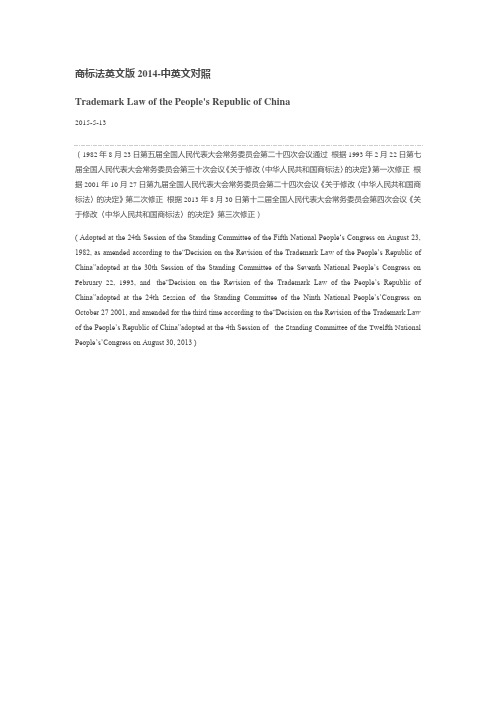
商标法英文版2014-中英文对照Trademark Law of the People's Republic of China2015-5-13(1982年8月23日第五届全国人民代表大会常务委员会第二十四次会议通过根据1993年2月22日第七届全国人民代表大会常务委员会第三十次会议《关于修改〈中华人民共和国商标法〉的决定》第一次修正根据2001年10月27日第九届全国人民代表大会常务委员会第二十四次会议《关于修改〈中华人民共和国商标法〉的决定》第二次修正根据2013年8月30日第十二届全国人民代表大会常务委员会第四次会议《关于修改〈中华人民共和国商标法〉的决定》第三次修正)( Adopted at the 24th Session of the Standing Committee of the Fifth National People‘s Congress on August 23, 1982, as amended according to the“Decision on the Revision of the Trademark Law of the People’s Republic of China”adopted at the 30th Session of the Standing Committee of the Seventh National People’s Congress on February 22, 1993, and the“Decision on the Revision of the Trademark Law of the People’s Republic of China”adopted at the 24th Session of the Standing Committee of the Ninth National People’s’Congress on October 27 2001, and amended for the third time according to the“Decision on the Revision of the Trademark Law of the People’s Republic of China”adopted at the 4th Session of the Standing Committee of the Twelfth National People’s’Congress on August 30, 2013 )目录Table of Contents第一章总则Chapter 1 General Provisions第二章商标注册的申请Chapter 2 Application for Trademark Registration第三章商标注册的审查和核准Chapter 3 Examination and Approval of Trademark Application第四章注册商标的续展、变更、转让和使用许可Chapter 4 Renewal, Assignment, and Licensing of Trademark Registrations 第五章注册商标的无效宣告Chapter 5 Adjudication of disputes Concerning Registered Trademarks第六章商标使用的管理Chapter 6 Administration of the Use of Trademarks第七章注册商标专用权的保护Chapter 7 Protection of the Exclusive Rights to Use Registered Trademarks 第八章附则Chapter 8 Supplementary Provisions第一章总则Chapter 1 General Provisions第一条为了加强商标管理,保护商标专用权,促使生产、经营者保证商品和服务质量,维护商标信誉,以保障消费者和生产、经营者的利益,促进社会主义市场经济的发展,特制定本法。
商标法英文版
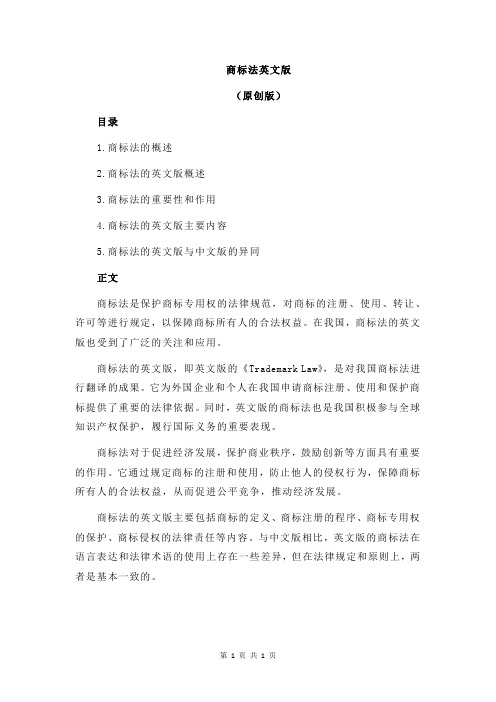
商标法英文版
(原创版)
目录
1.商标法的概述
2.商标法的英文版概述
3.商标法的重要性和作用
4.商标法的英文版主要内容
5.商标法的英文版与中文版的异同
正文
商标法是保护商标专用权的法律规范,对商标的注册、使用、转让、许可等进行规定,以保障商标所有人的合法权益。
在我国,商标法的英文版也受到了广泛的关注和应用。
商标法的英文版,即英文版的《Trademark Law》,是对我国商标法进行翻译的成果。
它为外国企业和个人在我国申请商标注册、使用和保护商标提供了重要的法律依据。
同时,英文版的商标法也是我国积极参与全球知识产权保护,履行国际义务的重要表现。
商标法对于促进经济发展,保护商业秩序,鼓励创新等方面具有重要的作用。
它通过规定商标的注册和使用,防止他人的侵权行为,保障商标所有人的合法权益,从而促进公平竞争,推动经济发展。
商标法的英文版主要包括商标的定义、商标注册的程序、商标专用权的保护、商标侵权的法律责任等内容。
与中文版相比,英文版的商标法在语言表达和法律术语的使用上存在一些差异,但在法律规定和原则上,两者是基本一致的。
第1页共1页。
美国商标法规定有什么-

美国商标法规定有什么?“商标”包括文字、名称、符号、图形或者其组合,由制造者或者商人用以识别其商品,以区别于他人生产或者销售者。
美国商标含意包括服务商标、集体商标和保证商标。
商标可以是平面视觉商标,也可以是立体的(三维)视觉商标,也允许音响商标即听觉商标注册。
▲一、美国商标法规定有什么?“商标”包括文字、名称、符号、图形或者其组合,由制造者或者商人用以识别其商品,以区别于他人生产或者销售者。
美国商标含意包括服务商标、集体商标和保证商标。
商标可以是平面视觉商标,也可以是立体的(三维)视觉商标,也允许音响商标即听觉商标注册。
1.申请基础。
美国对商标专用权的确立采用使用在先的原则,一个商标只要投入商业使用,即使没有注册,也拥有商标专用权,在发生商标专用权争议时,美国专利局将裁定商标专用权属于最先使用者。
除使用在先原则外,下列条件也可成为在美国申请商标注册的基础:(1)意向使用,即申请人有打算在美国使用的真实意图。
(2)原属国申请。
虽然申请人在本国已申请注册,而尚未获准注册,但必须已取得申请日期和申请号。
(3)原属国注册,即已在本国取得商标注册证。
2.申请人资格。
无论商标所有人为个人、公司、商号或社会团体,均可申请商标注册。
凡在美国有固定住所或工商企业的外国人,可按本国人同等待遇,对其他外国人,一般按对等原则处理。
不居住于美国的商标申请人,需委托代理人代为办理。
3.禁用条款。
任何用文字、符号或标志,或这些事物的组合作为商标,以区别申请人的产品而不违禁例者,均可予以注册,但下列内容不能作为商标注册:(1)含有不道德、欺骗或丑恶的事物,或者含有个人组织、信仰或国家象征进行诽谤或虚伪和它们的关系使之丧失信誉的事务。
(2)含有合众国或某一州、市或某一外国的旗帜、国徽或其他徽章,或其他仿制品。
(3)未经本人书面同意,使用在世的某人姓名、肖像或签字式样者;或美国某一已故总统的夫人仍健在时,使用该已故总统的姓名、遗像或签字式样,而未经总统夫人书面同意者。
美国商标使用声明

一、申请美国商标需要注意的问题(一)、商标美国专利商标局对商标的审查十分严格,因此申请人针对不同类型的商标需要注意以下问题:1、中文商标可以在美国提交申请,但是申请人需要提供构成该商标的每一个中文字的读音以及相应的英文翻译。
2、如果商标是由简单的英文字母组成,并且这些字母没有进行风格化的修饰,为了使商标受保护的范围更广,我们通常会建议申请人提交申请时声明该商标为普通字体(Standard Charaters),即不声明保护任何颜色、大小、字体。
这里所说的普通字体,通常指TIMES NEW ROMAR 或ARIAL。
3、商标如果为彩色,需要具体说明每个部分的颜色。
值得注意的是,如果商标为灰色,美国专利商标局将认定该商标为彩色商标。
4、必须明确指出该商标是否在相关商业或贸易、地理描述或其他语言上有特殊含义。
另外,美国专利商标局对提供的商标图样的要求也非常严格。
商标图样必须清晰,不能有任何模糊感。
由于美国商标申请大多采用电子提交的方式,因此,申请人需要提供图片格式的商标图样(如:jpg格式),美国专利商标局对图片格式的像素也有要求,不能小于250像素大于944像素。
(二)、商品/服务项目的选择虽然美国不限制提交申请的商品/服务的个数,但是由于美国主张“使用”原则,因此申请人在选择商品/服务时一定要限定为确实在生产销售的商品或者提供的服务,切不可认为提交的商品越多,商标保护的范围就越广,从而选择一些根本没有在生产销售或提供的服务。
这样做很可能会导致整个商标被撤销。
另外,美国虽然遵循国际尼斯分类,但是其商品服务项目往往比尼斯分类中的商品服务项目要求更加细化。
比如,商品“计算机周边设备”是尼斯分类中规范的商品项目,但是该项商品在美国不能被接受,原因就在于商品“计算机周边设备”的范围太宽泛,不具体。
如果要想被美国专利商标局接受,必须细化到“键盘、鼠标、调制解调器、扫描仪、打印机等等”。
我们建议申请人在选择准备申请的商品/服务时,可以提供该商品/服务在行业内的通用名称,而不必刻板的按照中国商标局出版的《类似商品和服务区分表》提供的商品/服务名称来进行选择。
美国商标使用

美国商标法中关于“商标使用”的规定非常严格,不仅只有已经在美国使用的商标才能最终获得注册,而且对于注册成功的商标也有强制使用的规定,否则注册商标也会被美国专利商标局主动撤销。
那么美国专利商标局又如何掌控商标是否有在美国合法的使用呢?其主要途径是要求商标申请人或注册人定期向美国专利商标局提交商标所附之商品/服务在美国使用的证据。
本篇文章将围绕商标使用证据着重介绍提交的时间、方式以及注意事项。
一、提交使用证据的几种情况依据美国商标法,从提交商标申请开始到商标续展时一共需要提交三次商标的使用证据。
按照美国商标申请注册的流程,我们可以将其分为三个阶段,即商标申请中、商标注册后以及商标续展时。
1、商标申请中提交美国商标申请有三个基础,即“基于打算使用”(ITU,Intent to use),“基于已经使用”(USE),或者“基于一项国外注册”(A foreign registration)。
选择不同的提交基础,其对于使用证据的规定和要求也不尽相同。
具体如下:(一)“基于打算使用”(ITU,Intent to use)1)时间:商标申请通过审查并公告且无人提出异议,此时美国专利商标局将下发授权通知(Notice of Allowance)。
从下发授权通知之日起6个月需要提交使用证据。
最长时间为从下发授权通知之日起三年。
2)延期以及要求:如果申请人此时还没有将商标在美国使用或者暂时提供不了使用证据,可以在限届满前向美国专利商标局提出延期申请,每次延期请求可以获得额外6个月期限,理论上共可以延期5次。
但是在实践中随着延期次数的增加,审查员对于申请人延期请求的审核也越来越严格。
比如,申请人提出的第一次延期请求不需要提供任何理由,但是从第二次延期开始,申请人均需要提供合理的延期理由。
通常情况下,审查员很难核准超过24个月的延期。
3)后果:商标使用证据必须提交,未提交视为放弃申请。
(二)“基于已经使用”(USE)以“已经使用”为基础提交的美国申请,必须在申请时一并提交使用证据,否则美国专利商标局不会受理商标申请。
美国法典 第22章 商标

美国法典第22章商标〈按1988年商标法修改法案(公法100-667, 1988年11月16日)最后修正〉I主注册簿1051.注册;申请;交费;为送达程序处理文件和通知书指定常驻代表1052.可在主注册簿上注册的商标;并存注册1053.服务商标可予注册1054.集体商标和证明商标可予注册1055.由有关公司使用影响有效性和注册1056.放弃不能注册的内容1057.注册证1058.注册有效期;撤销;连续使用保证书;局长意见通知书1059.续展注册1060.商标转让;履行手续;备案;未经通知的购买人1061.承认书和证明书的签署手续 1062.公告;驳回注册的程序;依先前法案注册的商标的重新公告 1063.对注册异议1064.撤销注册1065.在某些条件下,商标使用权的不容置疑性1066.抵触;由局长宣布1067.抵触、异议、以及关于并存使用注册或请求撤销的诉讼;通知;商标审理和上诉委员会1068.同上;局长的审理意见1069.在当事人之间诉讼中,衡平法原则的应用1070.向商标审理和上诉委员会提出对审查员决定的上诉1071.向法院上诉1072.注册即所有权要求的推定通知Ⅱ.副注册簿1091.可在副注册簿上注册的商标;注册申请和程序;商标性质;在对外商务中使用的商标1092.公告;不受异议;撤销1093.主注册簿和副注册簿的商标注册证不同1094.本章可适用于副注册簿上注册的条款1095.不排除在主注册簿上注册1096.在副注册簿上的注册不能用以阻止进口Ⅲ.一般条款1111.注册通告;在商标上展示;在侵权诉讼中追索权益和赔偿1112.商品和服务分类;在多个类别上注册1113.费用1114.补救;侵权;印刷和出版商无知侵权1115.在主注册簿上的注册为商标专用权的证据;辩护 1116.禁令;执行;通知局长1117.对侵犯权利的追索;收益、损害赔偿和诉讼费;律师费1118.销毁侵权物品1119.法院对注册的权力1120.对虚假的或欺骗性的注册所负民事责任1121.联邦法院的管辖权1122.各州、州的机关和州的官员的责任1123.专利商标局内的程序实施规章条例1124.禁止进口带有侵权商标或名称的商品1125.虚假的原产地标记、虚假的描述和淡化1126.国际公约1127.解释和定义;本章目的Ⅰ.主注册簿1051.注册;申请;交费;为送达程序处理文件和通知书指定常驻代表[第1条](a)用于商业的商标的所有人可依本章申请在本法建立的主注册簿上注册其商标:(1)向专利商标局提交--(A)一份申请书,按照局长规定的格式,经由申请人或申请单位的官员签署作证,写明申请人的住址和公民身份、申请人第一次使用该商标的日期、申请人在商业上第一次使用该商标的日期、使用该商标的有关商品和有关此类商品使用该商标的方式,并包括作证人的声明,证明确信其本人或其所代表的公司或机构确系申请注册的商标的所有人,并且该商标确系正在商业中使用,并且据其所知和相信,无他人有权在商业中使用与该商标相同或相似的商标,以致该他人在所述有关商品的使用可能引起混淆、误认或欺骗的情况;倘若是提出并存使用要求的申请,申请人应阐明有关其专用权要求的例外情况,应据其所知说明他人并存使用的情况、现有的并存使用的有关商品、并存使用的领域、每一使用的期限,以及申请人拟注册的商品和领域;(B)该商标的图样;(C)按局长要求的份数提交该商标的使用样品或精确复制品。
联邦商标稀释法

联邦商标稀释法联邦商标稀释法(Federal Trademark Dilution Act)是指美国的一项法律,旨在保护著名商标不受其他人使用同样或相似的商标的侵犯,以免其价值被稀释。
该法案于1995年通过,实施于1996年。
传统上,商标法要求商标所有者证明侵权行为使得注册商标在市场上失去識别度,商标稀释法则更进一步,无需证明商标在市场上失去識别度,而是认定侵权行为已经损害了商标的唯一性和卓越性。
以前的商标法仅适用于商标使用者和某个同类别业务的对手之间的情况,而联邦商标稀释法是一种更广泛的保护。
该法案为商标所有人增加了一种新的起诉维权的途径,添加了商标稀释为独立侵权行为的认定。
该法案要求商标稀释诉讼以潜在的商标損失为基础,而不是以市场損失为基础。
也就是说,即使商标在市场上并没有受到影响,商标所有人也可以在意见中主张商标稀释。
而且,该法律规定,即使两个商标活动没有任何实际的冲突,商标的潜在标准和市场声誉在某些情况下也可以被认定为构成商标稀释。
根据该法案的规定,商标稀释行为具有以下五个要件:(1)该被告与商标所有人拥有过去或现在的商业连结;(2)该被告使用了与商标所有人的商标相同或类似的商标;(3)该商标已成为著名商标;(4)该被告的商标使用使得商标所有人的商标唯一性受到侵害;(5)该被告的商标使用是经营中的使用。
尽管商标稀释法用于保护获得独家商标权的公司免受竞争行为的关注,但它本身也受到了一些质疑。
一些批评者指出,该法案的扩大解释和更广泛的适用有可能导致将许多常规和无害的商业活动视为商标稀释行为。
此外,还有批评者认为该法案削弱了竞争的原则,并可能阻碍了新公司和新产品进入市场的能力。
无论如何,联邦商标稀释法到目前为止是美国商标法领域中的一项重要规则,为商标所有人提供了更强有力的保护。
该法案为商标所有人提供了新的起诉维权途径,增加了商标保护的强度,还诱导了商标商业管理上的更多警惕性。
美国商标合理使用原则的最新发展:The Beach Boys一案评析(邱进前)

美国商标合理使用原则的最新发展:The Beach Boys一案评析邱进前上传时间:2006-6-2电子知识产权200505商标合理使用,是指他人在生产经营活动中可以正当地使用权利人的商标,而不必征得权利人的许可并不必支付商标使用费。
商标合理使用原则是商标法的重要组成部分,是对商标权利人的权利限制。
该原则的目的是为了平衡商标权利人与他人的合法权利以及兼顾社会公共利益。
商标合理使用是法律为达到各种社会主体之间的利益平衡而设计的一种制度。
美国在商标合理使用原则的立法和司法实践方面都比较发达。
1946年的《Lanham法令》规定了法定合理使用原则(Classic Fair Use)(注:国内有人把它称为:描述性合理使用(Descriptive Fair Use),参见武敏:“商标合理使用原则初探”,载《中华商标》,2002年第七期,第38页。
)。
上世纪90年代以来,美国司法实践创设了指示性合理使用(Nominative Fair Use),作为法定合理使用之补充。
指示性合理使用最早是在1992年New Kids On The Block v.News America Publising,Inc.(注:See 971 F.2d 302( 9th Cir.1992).)(下称“New Kids”)一案中确立的,在之后的2002年PlayboyEnterprises Inc.v.Terris Welles(注:See 279 F.3d 796(9th Cir.2002).)(下称“P EI”)一案得到进一步的发展,2003年的Brothers Records,Inc.v.Jardine4(下称“The Beach Boys”)一案对该原则的构成要件进行实质性的修订,以更好地协调其与法定合理使用原则的关系。
本文拟简要介绍并评析The Beach Boys案,探讨美国商标合理使用原则的最新发展。
一、案情介绍(一)案件事实1961年,被告Jardine和Dennis Wilson,Carl Wilson,Mike Love,Brian Wilson共同组成The Beach Boys乐队。
- 1、下载文档前请自行甄别文档内容的完整性,平台不提供额外的编辑、内容补充、找答案等附加服务。
- 2、"仅部分预览"的文档,不可在线预览部分如存在完整性等问题,可反馈申请退款(可完整预览的文档不适用该条件!)。
- 3、如文档侵犯您的权益,请联系客服反馈,我们会尽快为您处理(人工客服工作时间:9:00-18:30)。
15 U.S.C. § 1125(a) Civil action(1) Any person who, on or in connection with any goods or services, or any container for goods, uses in commerce any word, term, name, symbol, or device, or any combination thereof, or any false designation of origin, false or misleading description of fact, or false or misleading representation of fact, which--(A) is likely to cause confusion, or to cause mistake, or to deceive as to theaffiliation, connection, or association of such person with another person, or as to the origin, sponsorship, or approval of his or her goods, services, or commercialactivities by another person, or(B) in commercial advertising or promotion, misrepresents the nature,characteristics, qualities, or geographic origin of his or her or another person'sgoods, services, or commercial activities,shall be liable in a civil action by any person who believes that he or she is or is likely to be damaged by such act.(2) As used in this subsection, the term “any person” includes any State, instrumentality of a State or employee of a State or instrumentality of a State acting in his or her official capacity. Any State, and any such instrumentality, officer, or employee, shall be subject to the provisions of this chapter in the same manner and to the same extent as any nongovernmental entity.(3) In a civil action for trade dress infringement under this chapter for trade dress not registered on the principal register, the person who asserts trade dress protection has the burden of proving that the matter sought to be protected is not functional.(b) ImportationAny goods marked or labeled in contravention of the provisions of this section shall not be imported into the United States or admitted to entry at any customhouse of the United States. The owner, importer, or consignee of goods refused entry at any customhouse under this section may have any recourse by protest or appeal that is given under the customs revenue laws or may have the remedy given by this chapter in cases involving goods refused entry or seized.(c) Dilution by blurring; dilution by tarnishment(1) Injunctive reliefSubject to the principles of equity, the owner of a famous mark that is distinctive, inherently or through acquired distinctiveness, shall be entitled to an injunctionagainst another person who, at any time after the owner's mark has becomefamous, commences use of a mark or trade name in commerce that is likely to cause dilution by blurring or dilution by tarnishment of the famous mark, regardless of the presence or absence of actual or likely confusion, of competition, or of actual economic injury.(2) Definitions(A) For purposes of paragraph (1), a mark is famous if it is widely recognized by the general consuming public of the United States as a designation of source of the goods or services of the mark's owner. In determining whether a mark possesses the requisite degree of recognition, the court may consider all relevant factors, including the following:(i) The duration, extent, and geographic reach of advertising and publicityof the mark, whether advertised or publicized by the owner or thirdparties.(ii) The amount, volume, and geographic extent of sales of goods orservices offered under the mark.(iii) The extent of actual recognition of the mark.(iv) Whether the mark was registered under the Act of March 3, 1881, orthe Act of February 20, 1905, or on the principal register.(B) For purposes of paragraph (1), “dilution by blurring” is association arising from the similarity between a mark or trade name and a famous mark that impairs the distinctiveness of the famous mark. In determining whether a mark or trade name is likely to cause dilution by blurring, the court may consider all relevant factors, including the following:(i) The degree of similarity between the mark or trade name and thefamous mark.(ii) The degree of inherent or acquired distinctiveness of the famous mark.(iii) The extent to which the owner of the famous mark is engaging insubstantially exclusive use of the mark.(iv) The degree of recognition of the famous mark.(v) Whether the user of the mark or trade name intended to create anassociation with the famous mark.(vi) Any actual association between the mark or trade name and thefamous mark.(C) For purposes of paragraph (1), “dilution by tarnishment” is association arisingfrom the similarity between a mark or trade name and a famous mark that harmsthe reputation of the famous mark.(3) ExclusionsThe following shall not be actionable as dilution by blurring or dilution by tarnishment under this subsection:(A) Any fair use, including a nominative or descriptive fair use, or facilitation ofsuch fair use, of a famous mark by another person other than as a designation ofsource for the person's own goods or services, including use in connection with--(i) advertising or promotion that permits consumers to compare goods orservices; or(ii) identifying and parodying, criticizing, or commenting upon the famousmark owner or the goods or services of the famous mark owner.(B) All forms of news reporting and news commentary.(C) Any noncommercial use of a mark.(4) Burden of proofIn a civil action for trade dress dilution under this chapter for trade dress not registered on the principal register, the person who asserts trade dress protection has the burden of proving that--(A) the claimed trade dress, taken as a whole, is not functional and is famous; and(B) if the claimed trade dress includes any mark or marks registered on theprincipal register, the unregistered matter, taken as a whole, is famous separateand apart from any fame of such registered marks.(5) Additional remediesIn an action brought under this subsection, the owner of the famous mark shall be entitled to injunctive relief as set forth in section 1116 of this title. The owner of the famous mark shall also be entitled to the remedies set forth in sections 1117(a) and 1118 of this title, subject to the discretion of the court and the principles of equity if--(A) the mark or trade name that is likely to cause dilution by blurring or dilutionby tarnishment was first used in commerce by the person against whom theinjunction is sought after October 6, 2006; and(B) in a claim arising under this subsection--(i) by reason of dilution by blurring, the person against whom theinjunction is sought willfully intended to trade on the recognition of thefamous mark; or(ii) by reason of dilution by tarnishment, the person against whom theinjunction is sought willfully intended to harm the reputation of thefamous mark.(6) Ownership of valid registration a complete bar to actionThe ownership by a person of a valid registration under the Act of March 3, 1881, or the Act of February 20, 1905, or on the principal register under this chapter shall be a complete bar to an action against that person, with respect to that mark, that--(A)(i) is brought by another person under the common law or a statute of a State;and(ii) seeks to prevent dilution by blurring or dilution by tarnishment; or(B) asserts any claim of actual or likely damage or harm to the distinctiveness orreputation of a mark, label, or form of advertisement.(7) Savings clauseNothing in this subsection shall be construed to impair, modify, or supersede the applicability of the patent laws of the United States.(d) Cyberpiracy prevention(1)(A) A person shall be liable in a civil action by the owner of a mark, including a personal name which is protected as a mark under this section, if, without regard to the goods or services of the parties, that person(i) has a bad faith intent to profit from that mark, including a personal name whichis protected as a mark under this section; and(ii) registers, traffics in, or uses a domain name that--(I) in the case of a mark that is distinctive at the time of registration of thedomain name, is identical or confusingly similar to that mark;(II) in the case of a famous mark that is famous at the time of registrationof the domain name, is identical or confusingly similar to or dilutive ofthat mark; or(III) is a trademark, word, or name protected by reason of section 706 ofTitle 18 or section 220506 of Title 36.(B)(i) In determining whether a person has a bad faith intent described under subparagraph (a), a court may consider factors such as, but not limited to(I) the trademark or other intellectual property rights of the person, if any, in thedomain name;(II) the extent to which the domain name consists of the legal name of the person or a name that is otherwise commonly used to identify that person;(III) the person's prior use, if any, of the domain name in connection with thebona fide offering of any goods or services;(IV) the person's bona fide noncommercial or fair use of the mark in a siteaccessible under the domain name;(V) the person's intent to divert consumers from the mark owner's online location to a site accessible under the domain name that could harm the goodwillrepresented by the mark, either for commercial gain or with the intent to tarnish or disparage the mark, by creating a likelihood of confusion as to the source,sponsorship, affiliation, or endorsement of the site;(VI) the person's offer to transfer, sell, or otherwise assign the domain name to the mark owner or any third party for financial gain without having used, or havingan intent to use, the domain name in the bona fide offering of any goods orservices, or the person's prior conduct indicating a pattern of such conduct;(VII) the person's provision of material and misleading false contact informationwhen applying for the registration of the domain name, the person's intentionalfailure to maintain accurate contact information, or the person's prior conductindicating a pattern of such conduct;(VIII) the person's registration or acquisition of multiple domain names which the person knows are identical or confusingly similar to marks of others that aredistinctive at the time of registration of such domain names, or dilutive of famous marks of others that are famous at the time of registration of such domain names, without regard to the goods or services of the parties; and(IX) the extent to which the mark incorporated in the person's domain nameregistration is or is not distinctive and famous within the meaning of subsection(c) of this section.(ii) Bad faith intent described under subparagraph (A) shall not be found in any case in which the court determines that the person believed and had reasonable grounds to believe that the use of the domain name was a fair use or otherwise lawful.(C) In any civil action involving the registration, trafficking, or use of a domain name under this paragraph, a court may order the forfeiture or cancellation of the domain name or the transfer of the domain name to the owner of the mark.(D) A person shall be liable for using a domain name under subparagraph (A) only if that person is the domain name registrant or that registrant's authorized licensee.(E) As used in this paragraph, the term “traffics in” refers to transactions that include, but are not limited to, sales, purchases, loans, pledges, licenses, exchanges of currency, and any other transfer for consideration or receipt in exchange for consideration.(2)(A) The owner of a mark may file an in rem civil action against a domain name in the judicial district in which the domain name registrar, domain name registry, or other domain name authority that registered or assigned the domain name is located if(i) the domain name violates any right of the owner of a mark registered in thePatent and Trademark Office, or protected under subsection (a) or (c) of thissection; and(ii) the court finds that the owner--(I) is not able to obtain in personam jurisdiction over a person who wouldhave been a defendant in a civil action under paragraph (1); or(II) through due diligence was not able to find a person who would havebeen a defendant in a civil action under paragraph (1) by--(aa) sending a notice of the alleged violation and intent to proceedunder this paragraph to the registrant of the domain name at thepostal and e-mail address provided by the registrant to theregistrar; and(bb) publishing notice of the action as the court may directpromptly after filing the action.(B) The actions under subparagraph (A)(ii) shall constitute service of process.(C) In an in rem action under this paragraph, a domain name shall be deemed to have its situs in the judicial district in which(i) the domain name registrar, registry, or other domain name authority thatregistered or assigned the domain name is located; or(ii) documents sufficient to establish control and authority regarding thedisposition of the registration and use of the domain name are deposited with the court.(D)(i) The remedies in an in rem action under this paragraph shall be limited to a court order for the forfeiture or cancellation of the domain name or the transfer of the domain name to the owner of the mark. upon receipt of written notification of a filed, stamped copy of a complaint filed by the owner of a mark in a United States district court underthis paragraph, the domain name registrar, domain name registry, or other domain name authority shall(I) expeditiously deposit with the court documents sufficient to establish thecourt's control and authority regarding the disposition of the registration and useof the domain name to the court; and(II) not transfer, suspend, or otherwise modify the domain name during thependency of the action, except upon order of the court.(ii) The domain name registrar or registry or other domain name authority shall not be liable for injunctive or monetary relief under this paragraph except in the case of bad faith or reckless disregard, which includes a willful failure to comply with any such court order.(3) The civil action established under paragraph (1) and the in rem action established under paragraph (2), and any remedy available under either such action, shall be in addition to any other civil action or remedy otherwise applicable.(4) The in rem jurisdiction established under paragraph (2) shall be in addition to any other jurisdiction that otherwise exists, whether in rem or in personam.。
